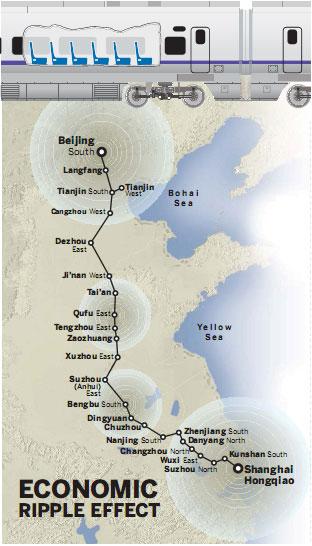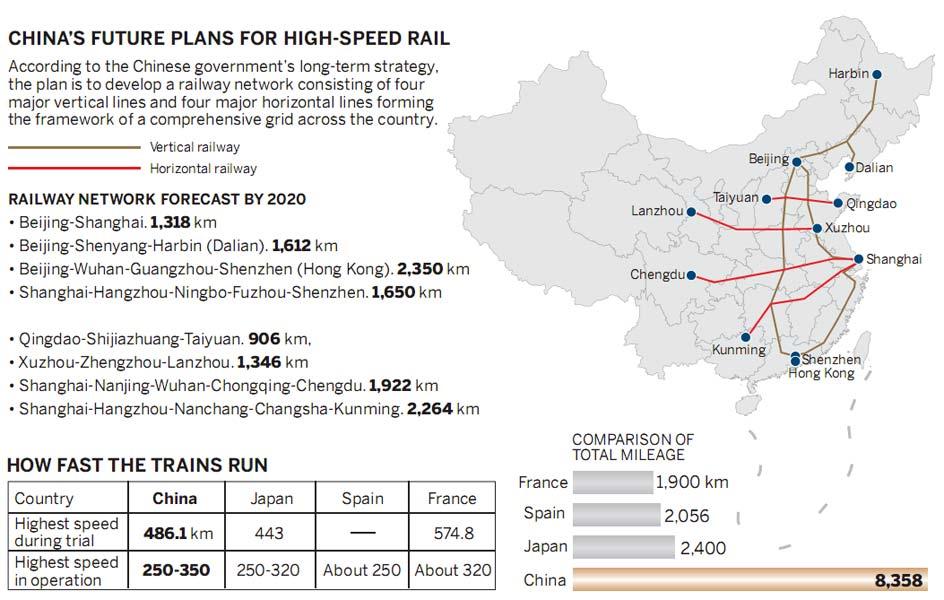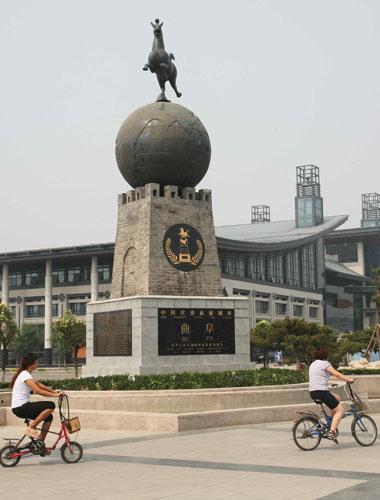 Jinan and Tai'an: Towering expectations
Jinan and Tai'an: Towering expectations
Two more Shandong cities - Tai'an, famous for its mountain, the Taishan and Jinan, famous for its springs - are also ready for fresh tourism and investment opportunities rolling in at high speed.
"We aim to make Tai'an into an international tourism city. The high-speed railway will definitely help us achieve our goal as the train will bring more tourists, including foreigners, from Beijing, Shanghai, Nanjing and Suzhou," Liu Shui, the deputy head of Tai'an Tourism Bureau said.
To maximize the advantages, cities along the high-speed rail route in Shandong are joining forces in a high-speed railway tourism union comprising the cities of Qufu, Tai'an and Dezhou. This alliance will sharpen the province's competitive edge in tourism, according to Liu.
Jinan, the provincial capital, plans to invest a total of 350 billion yuan over 10 years to build a 55-square kilometer urban complex centered around the high-speed railway station.
"I believe Jinan will undergo a grand change thanks to the high-speed railway. The trains are expected to bring in a daily passenger flow of 100,000 people to Jinan," Lu Hua, director of the planning office for western Jinan said.
To accommodate the large numbers, Jinan is making sure there is easy access to bus stations, taxi stops, parking lots and coach stations.
The main concourse of the Jinan West Station is already complete. To give alighting passengers a pleasant first impression, extensive landscaping was carried out in front of the concourse.
And, not far away, a cultural center and an exhibition center are under construction. According to Lu Hua, the urban complex will house around 600,000 people when completed.
"The Beijing-Shanghai High-speed Railway elevates Jinan to the level of China's most bustling metropolises. This will have great impact over our urban development," Yin Qingzhong, deputy head of Jinan's reform and development commission, said.
And with such a rosy future on the horizon, property prices are also surging.
The going rate for a real estate project under construction one and a half kilometers away from Jinan West Station has surged to 6,400 yuan per square meter, up from 4,000 yuan in 2009.
In Shandong, the railway promises to open up more opportunities as the province welcomes the trains zipping their way along a coastal route that will level the playing ground in trade, tourism, manufacturing and property, among others.

A billboard advertises the rail ambitions of Jinan. The Shandong capital determined to exploit the new business opportunities the high-speed trains will ferry into the city. [Photo/China Daily]


Qufu's one-stop tourist center will make it easier for visitors wanting to rent a car or a bicycle, book a tour, taxi or train, or just simply find out more about Confucius' hometown. [Photo/China Daily]
Qufu: If Confucius could imagine this now
When Confucius left for Jinan to teach, he traveled by road for a week from his hometown of Qufu. The Chinese philosopher lived during the Spring and Autumn Period (770-476 BC), and it would have been beyond his wildest imagination to think his journey could have taken less then an hour, or quicker than the time for an average class he taught.
More than 2,500 years after his time, the bullet trains shuttling between Beijing and Shanghai will now whizz into Qufu, and the sage's hometown is preparing itself for even more visitors than usual.
The Beijing-Shanghai High-speed Rail will stop at six cities in East China's Shandong province, and there is much exhilaration and expectation.
"My 87-year-old father can't wait to go to Beijing by the high-speed train," Liang Hu, in his 50s, said. Liang had hurried to the Qufu East Station to try to get tickets for the first day of service.
"I go on frequent business trips to Beijing and Shanghai. When the high-speed train is in service, I will definitely prefer the train to planes," Liang said, "It's more convenient to take the trains at Qufu East Station, than for me to travel to the airport and take the plane."
Qufu East Station was specially constructed to facilitate the bullet train services, and is only 15 kilometers from where Liang works.
Qufu's revenue comes mainly from tourism, thanks to the legacy from China's most famous sage.
The attractions are the Confucius Family Mansion, the family mausoleum and the Confucius Temple, and an information hub named after Confucius and Mencius is getting ready outside the Qufu East Station.
The center integrates a travel agency, airport ticketing and transfer services, hotel bookings and transport information and is a one-stop shop for tourists.
"We expect a daily flow of 3000 tourists. Currently, we have 20 vehicles in place to meet tourists' travel requirements," an employee at the tourism center said.
The city itself has also gotten spruced up to meet the expected tourism boom.
Qufu has upgraded its roads and traffic infrastructure.
A six-lane avenue named after Confucius now connects the high-speed station with several tourism sites, including the Confucius Temple and the Confucius Family Mansion.
Along the avenue, posters and banners declare: "High-speed railway changes life".
And it certainly will.





